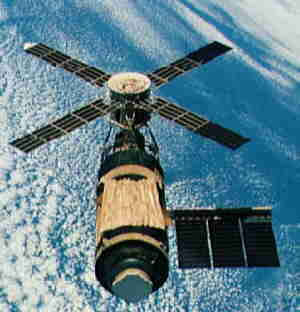 SKC Films Library SKC Films Library |
||||||||||
| SKC Films Library >> Technology >> Astronautics >> Manned Programs and Missions | ||||||||||
| Project Skylab the first American space station
Launched on May 14, 1973, Project Skylab was designed to demonstrate that man could work and live in space for prolonged periods without ill effect. The Skylab module itself, originally the spent third stage of a Saturn V moon rocket, measured 118 feet from end to end and carried the most varied assortment of experimental equipment ever assembled in a single spacecraft. A total of three three-man crews were sent to the station, with the first crew launched May 25, 1973. Over the course of the project more than 740 hours were spent observing the Sun and over 175,000 solar pictures were taken -- including the first recordings of solar activity taken above Earth's atmosphere. Skylab also evaluated systems designed to gather information on Earth's resources and environmental conditions. Biomedical research conducted on the station indicated that man adapts well to space for periods of at least three months, provided he has a proper diet and adequately programmed exercise, sleep, work, and recreation periods. The Skylab module was designed to provide astronauts with some degree of living comfort, with the first-ever "space shower," sleeping compartments, waste facilities, recreational space, and a specially-designed triangular grid floor that allowed the astronauts to "walk around" using special shoes equipped with matching triangular cleats. Many of the innovations first used in the Skylab program were modified over the following years and have made their way into more current space programs, including the Space Shuttle. cutaway view of the Skylab workshop The third (and ultimately final) mission in the program was launched November 16, 1973. Before leaving Skylab, the third crew nudged the module into an orbit designed to give the station a projected lifespan of 10 years. However, due to unexpectedly high sunspot activity, the orbit of Skylab began to deteriorate in early 1979. On July 11, 1979, the Skylab module fell out of orbit; the parts that did not burn up in the atmosphere came crashing down on parts of Australia and the Indian Ocean -- including one piece the size of a school bus. Fortunately, and amazingly, no one was injured and no significant property damage was reported due to the "fall out." Skylab debris recovered from Australia In spite of Project Skylab's short lifespan and some early mechanical difficulties, the project was successful in every way.
SEE ALSO |
||||||||||
| SKC Films Library >> Technology >> Astronautics >> Manned Programs and
Missions This page was last updated on 05/27/2017. |
||||||||||
